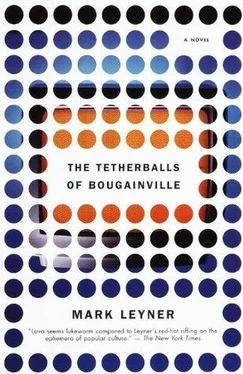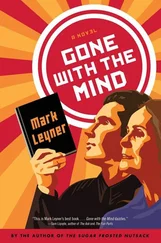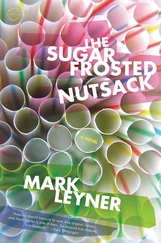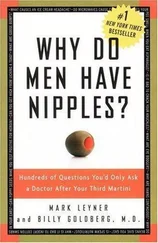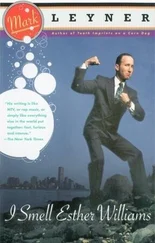“How do you feel about it?” my father asks, turning to the rabbi.
“It’s a very postmodern sentencing structure — random and capricious, the free-floating dread, each ensuing day as gaping abyss, the signifier hovering over the signified like the sword of Damocles. To have appropriated a pop-noir aesthetic and recontextualized it within the realm of jurisprudence is breathtakingly audacious. I think you’re going to find it a very disturbing, but a very fascinating and transformative way to live, Joel.”
Personally, I don’t find it all that innovative, audacious, disturbing, fascinating, or transformative. It just seems like normal life to me — not knowing from day to day if you’ll be pithed with a pub dart or sliced into sushi by some hypopituitary freak in black pajamas, or if your false teeth will blow up in your head. That’s just late-second-millennium life. I mean, isn’t everyone basically sentenced to New Jersey State Discretionary Execution from, like, the moment he’s born?
Although, OK — I have to admit — a statutory algorithm designed to amplify the anarchic cruelties of human existence and arbitrarily inflict its violence upon innocent bystanders, exponentially expanding the nexus of fatal contingencies, is pretty intense. And also, I assume that any ninja who works for NJSDE is involved in the state civil service bureaucracy — and there’s something really appealing to me about the image of ninjas waiting in lines for hours at state offices for application forms and photo IDs. And I absolutely adore the notion of elite units of New Jersey State Troopers, magnificently loathsome in their Stetsons and jackboots, sworn by blood oath to enforce the stringent dicta of NJSDE, wending the corniches of the French Riviera or the Spanish Costa del Sol in their emblazoned cruisers, in inexorable pursuit of some targeted releasee, some hapless New Jersey expatriate shambling along the boardwalk, camera and wine sack slung across his belly, oblivious to the cataclysmic, surreal violence in which he’ll be momentarily engulfed.
But do I say any of this when the rabbi, in turn, asks me what I think of NJSDE? No, of course not. Instead I mutter some facile, meaningless catchphrase.
Why do I nullify my own intelligence with this willful, stereotypical inarticulateness? Why do I immure my thoughts in this crypt of sullen diffidence?
Do I perhaps derive some sadomasochistic pleasure in the mortification of my own intellect, akin to those who cut and burn their own bodies? After all, isn’t the act of making oneself mute a mute-ilation?
Am I ultimately knowable?
Is it ludicrous and stilted for a 13-year-old to describe himself, even facetiously, as “an individual of daunting complexity”?
Why is it, then, that when the rabbi, in turn, asks me what I think of NJSDE, I glibly reply: “It’s cool, like a video”?
The warden returns.
“This should help answer any questions you might have, Mr. Leyner,” she says, handing my father a booklet, which I peruse over his shoulder.
The glossy brochure is entitled You and Your Discretionary Execution .
Q. What is New Jersey State Discretionary Execution?
A. NJSDE was developed by Alejandro Roberto Montés Calderón, a cashiered Guatemalan Army colonel who fled Guatemala after his counterinsurgency unit was accused of “crimes against humanity” by Americas Watch and Amnesty International. Mr. Calderón resettled in the United States, where he became a gym teacher at Emerson High School in Union City, New Jersey. The Governor, who had Mr. Calderón for gym in both her junior and senior years, appointed him to chair the Select Committee on Capital Punishment and Tort Reform.
NJSDE is a pioneering sentencing program designed to give the State of New Jersey maximum — one might even say giddy —latitude in dealing with condemned inmates, like yourself, who have survived unsuccessful institutional executions.
Q. Am I responsible for the cost of my unsuccessful institutional execution?
A. You are responsible only for the cost of the lethal drugs. Most health insurance plans and HMOs cover lethal prescription drugs, paying for them directly or through reimbursements to the insured individual. Check your policy and consult with your broker or benefits administrator.
Q. How does the State determine whether I will live or die?
A. Your status is reevaluated on a daily basis. At precisely 9:00 P.M. each night, at the New Jersey State Discretionary Execution Control Center in Trenton, data processors insert every NJSDE releasee’s social security number into an intricate equation whose variables include the current pollen count at Newark International Airport and the total daily receipts collected at toll-booths along the Garden State Parkway as of 7:45 P.M. If, factored through this algebraic operation, your SS number yields a prime number, any five-digit sequence from pi, or the Governor’s PIN code for her MAC card, you are subject to Discretionary Execution over that ensuing 24-hour period.
Q. Is NJSDE painful?
A. Yes! The State avails itself of a potpourri of execution methods including bare hands and teeth, sharpened stick, flint ax, bisection by lumberyard circular saw, car bomb, drive-by shooting, rocket-propelled grenade, Tomahawk cruise missile, etc., any of which can cause significant discomfort. The degree of pain you experience may vary in accordance with the efficacy of the execution attempt and with your body’s ability to produce natural opiates, called endorphins, at moments of extreme stress. If you choose to augment your endorphins by prophylactically self-anesthetizing through heavy alcohol consumption and you develop cirrhosis, bear in mind that some hospitals in New Jersey will not perform liver transplants on patients who face possible execution within 48 hours of surgery.
Q. How does the State make certain it’s executing the right person?
A. Prior to any execution attempt, your identity will be surreptitiously confirmed using sophisticated DNA-fingerprinting autoradiograph techniques developed by the LAPD Forensic Crime Laboratory.
Q. What will happen to me after I’m killed?
A. You will experience a sense of well-being. You (i.e., your soul) will separate from your body. You will travel through a dark tunnel. Emerging from this darkness, you will encounter a field of white radiant light. And you will enter this light. You will conduct a review of your life. You may encounter a “presence.” You will probably meet deceased loved ones. At some juncture, you may hear what you think is your body calling out, beseeching you. Do not return to your body! This bark or whooping sound is made by a spasm in the muscles of the voice box caused by increased acidity in the blood of the corpse.
Your body will undergo rigor mortis (rigidity), livor mortis (discoloration due to settling of blood), and algor mortis (cooling). Tissue will break down through enzymatic action, and putrefaction will ensue through the decomposition of proteins by bacteria. Your body will be colonized by necrophage insects, including blowfly larvae and saprophagous beetles, and within three to six months, caseic fermentation should occur.
Q. This is a change of subject, but — Why, after he’d been so successful as a starting pitcher and in fact had recently thrown a no-hitter against the Boston Red Sox, was Dave Righetti pulled from the starting rotation and put in the Yankee bullpen? Was this just the result of one of Steinbrenner’s autocratic tantrums, or was there some sound baseball reasoning behind the decision?
A. The months following Righetti’s July Fourth no-hitter against the Boston Red Sox were among the most tumultuous in Yankee history. Players had the locker room repainted, replacing the traditional Yankee pinstripe motif with gyrating chained dancers and huge flying griffins bearing futuristic bare-breasted Valkyries with laser guns. Each game was preceded by a ritual team circle jerk. Post-game revels raged into the early morning. It was not unusual to find Meg Tilly, Teri Hatcher, Amanda Plummer, Vanessa Williams, Jaye Davidson, Kate Capshaw, Janet Reno, Daphne Zuniga, Helena Bonham Carter, and the like sprawled languidly across the locker-room floor as players sipped sweat from their navels with teeny coke spoons. Sports fans will not soon forget the image of a simpering Don Mattingly injecting Ritalin into his neck for the benefit of press photographers. Steinbrenner’s capricious mean streak was exacerbated by the cheese-free diet he’d been put on by his cardiologist. One minute, he seemed too spaced out to recognize anyone; the next, he was clubbing or pistol-whipping whoever was handy. Predictably, players and coaches oscillated between rhapsody and despair, their heady self-confidence undermined by an involuntary nihilism. Righetti, the crotch of his uniform distended by the heavy cock rings he now insisted on wearing when he pitched, circumambulated the mound between pitches muttering what a New York Post headline described as “Hermetic Incantations and Insane Glossolalia!” Righetti was ultimately placed on the disabled list and committed by Steinbrenner to the psychiatric hospital in Rodez, France, where the visionary dramatic theorist and poet Antonin Artaud had undergone sixty convulsive shock treatments. Pledging that his star pitcher would receive “the finest care money can buy,” Steinbrenner stipulated that Righetti be given sixty-one convulsive shock treatments — one for each of the home runs Roger Maris hit in 1961. Three weeks later, Righetti rejoined the team in Kansas City. That night, in the eleventh inning, Yankee utility infielder Hector Peña hit a mammoth 600-foot shot to dead center field. Following a protest by Royals manager Dick Howser that Peña was using an illegally doctored bat, umpires confiscated his Louisville Slugger, sawed it open, and discovered two pounds of stolen Russian plutonium. The Yankees were forced to forfeit the game and effectively dropped out of pennant contention. That off-season, in an effort to restore morale, Steinbrenner took the team on a tour of Japan, Southeast Asia, and the Indian subcontinent. Although several Yankees tore anterior cruciate ligaments slipping on the raspberry-colored snail-egg pods that litter ballparks in the Mekong lowlands of southwest Laos, and during a game in the Mujahedeen Dome in Kabul, Afghanistan, rookie prospect Andre Knoblauch lost his legs when he stepped on a land mine chasing a line-drive hit into the gap in left-center, the trip was a great success. Steinbrenner was particularly impressed with the custom practiced by Japanese players of wearing glass vials of potassium cyanide on cords around their necks. And in an exhibition game against the Yomiuri Giants, a Yomiuri player, caught in a run-down between second and third base, did indeed swallow his suicide capsule rather than suffer the ignominy of being tagged out. The Yankees returned to the United States, proceeding directly to Fort Lauderdale, and throughout spring training they evinced a renewed esprit de corps and seriousness of purpose. The new season began with extremely high expectations. But on opening day, several hours before game time, as starting pitcher Dave Righetti napped on a training table, his fingers interlocked behind his head, Knoblauch — in a stupid rookie prank — put a caramel apple in Righetti’s left armpit. When Righetti awoke and discovered the caramel apple stuck fast to the armpit of his pitching arm, he panicked and, seizing the wooden stick, wildly pried the agglutinated candy-coated winesap from his body, taking several layers of torn flesh with it. Righetti was rushed to a nearby hospital where surgeons performed an emergency graft using 53 infant foreskins donated by a Bronx mohel who was a rabid Yankee fan and had heard what happened on his car radio. Righetti returned to the stadium in time to pitch two innings of hitless relief, and remained in the bullpen for the rest of his tenure with the New York Yankees.
Читать дальше
